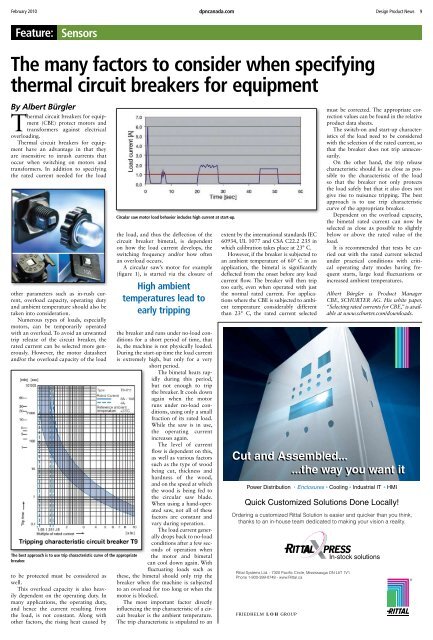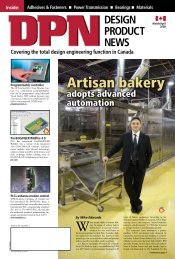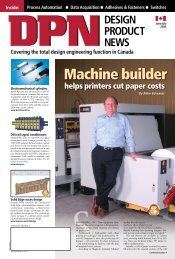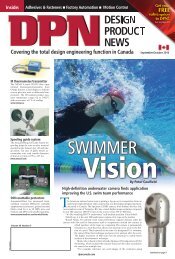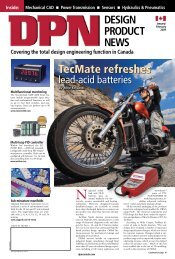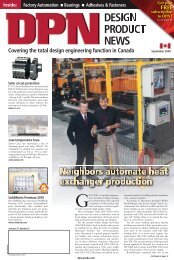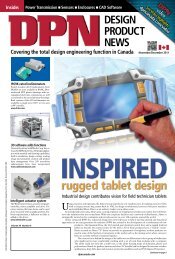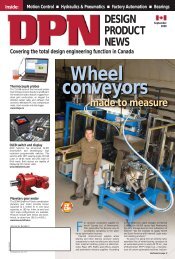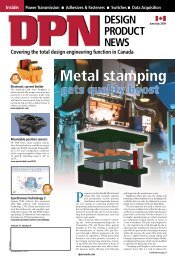Complete DPN February 2010 - Design Product News
Complete DPN February 2010 - Design Product News
Complete DPN February 2010 - Design Product News
You also want an ePaper? Increase the reach of your titles
YUMPU automatically turns print PDFs into web optimized ePapers that Google loves.
<strong>February</strong> <strong>2010</strong><br />
Feature: sensors<br />
dpncanada.com<br />
the many factors to consider when specifying<br />
thermal circuit breakers for equipment<br />
By Albert Bürgler<br />
Thermal circuit breakers for equipment<br />
(CBE) protect motors and<br />
transformers against electrical<br />
overloading.<br />
Thermal circuit breakers for equipment<br />
have an advantage in that they<br />
are insensitive to inrush currents that<br />
occur when switching on motors and<br />
transformers. In addition to specifying<br />
the rated current needed for the load<br />
other parameters such as in-rush current,<br />
overload capacity, operating duty<br />
and ambient temperature should also be<br />
taken into consideration.<br />
Numerous types of loads, especially<br />
motors, can be temporarily operated<br />
with an overload. To avoid an unwanted<br />
trip release of the circuit breaker, the<br />
rated current can be selected more generously.<br />
However, the motor datasheet<br />
and/or the overload capacity of the load<br />
the best approach is to use trip characteristic curve of the appropriate<br />
breaker.<br />
to be protected must be considered as<br />
well.<br />
This overload capacity is also heavily<br />
dependent on the operating duty. In<br />
many applications, the operating duty,<br />
and hence the current resulting from<br />
the load, is not constant. Along with<br />
other factors, the rising heat caused by<br />
circular saw motor load behavior includes high current at start-up.<br />
the load, and thus the deflection of the<br />
circuit breaker bimetal, is dependent<br />
on how the load current develops, the<br />
switching frequency and/or how often<br />
an overload occurs.<br />
A circular saw’s motor for example<br />
(figure 1), is started via the closure of<br />
High ambient<br />
temperatures lead to<br />
early tripping<br />
the breaker and runs under no-load conditions<br />
for a short period of time, that<br />
is, the machine is not physically loaded.<br />
During the start-up time the load current<br />
is extremely high, but only for a very<br />
short period.<br />
The bimetal heats rapidly<br />
during this period,<br />
but not enough to trip<br />
the breaker. It cools down<br />
again when the motor<br />
runs under no-load conditions,<br />
using only a small<br />
fraction of its rated load.<br />
While the saw is in use,<br />
the operating current<br />
increases again.<br />
The level of current<br />
flow is dependent on this,<br />
as well as various factors<br />
such as the type of wood<br />
being cut, thickness and<br />
hardness of the wood,<br />
and on the speed at which<br />
the wood is being fed to<br />
the circular saw blade.<br />
When using a hand-operated<br />
saw, not all of these<br />
factors are constant and<br />
vary during operation.<br />
The load current generally<br />
drops back to no-load<br />
conditions after a few sec-<br />
onds of operation when<br />
the motor and bimetal<br />
can cool down again. With<br />
fluctuating loads such as<br />
these, the bimetal should only trip the<br />
breaker when the machine is subjected<br />
to an overload for too long or when the<br />
motor is blocked.<br />
The most important factor directly<br />
influencing the trip characteristic of a circuit<br />
breaker is the ambient temperature.<br />
The trip characteristic is stipulated to an<br />
extent by the international standards IEC<br />
60934, UL 1077 and CSA C22.2 235 in<br />
which calibration takes place at 23° C.<br />
However, if the breaker is subjected to<br />
an ambient temperature of 60° C in an<br />
application, the bimetal is significantly<br />
deflected from the onset before any load<br />
current flow. The breaker will then trip<br />
too early, even when operated with just<br />
the normal rated current. For applications<br />
where the CBE is subjected to ambient<br />
temperature considerably different<br />
than 23° C, the rated current selected<br />
<strong>Design</strong> <strong>Product</strong> <strong>News</strong> 9<br />
Cut and Assembled...<br />
...the way you want it<br />
Power Distribution Enclosures Cooling Industrial IT HMI<br />
Quick Customized Solutions Done Locally!<br />
Ordering a customized Rittal Solution is easier and quicker than you think,<br />
thanks to an in-house team dedicated to making your vision a reality.<br />
Rittal Systems Ltd. - 7320 Pacific Circle, Mississauga ON L5T 1V1<br />
Phone 1-800-399-0748 - www.Rittal.ca<br />
must be corrected. The appropriate correction<br />
values can be found in the relative<br />
product data sheets.<br />
The switch-on and start-up characteristics<br />
of the load need to be considered<br />
with the selection of the rated current, so<br />
that the breaker does not trip unnecessarily.<br />
On the other hand, the trip release<br />
characteristic should lie as close as possible<br />
to the characteristic of the load<br />
so that the breaker not only protects<br />
the load safely but that it also does not<br />
give rise to nuisance tripping. The best<br />
approach is to use trip characteristic<br />
curve of the appropriate breaker.<br />
Dependent on the overload capacity,<br />
the bimetal rated current can now be<br />
selected as close as possible to slightly<br />
below or above the rated value of the<br />
load.<br />
It is recommended that tests be carried<br />
out with the rated current selected<br />
under practical conditions with critical<br />
operating duty modes having frequent<br />
starts, large load fluctuations or<br />
increased ambient temperatures.<br />
Albert Bürgler is <strong>Product</strong> Manager<br />
CBE, SCHURTER AG. His white paper,<br />
“Selecting rated currents for CBE,” is available<br />
at www.schurter.com/downloads.<br />
In-stock solutions<br />
Rittal_<strong>DPN</strong>_Feb10.indd 1 1/25/10 10:50:04 AM<br />
R


